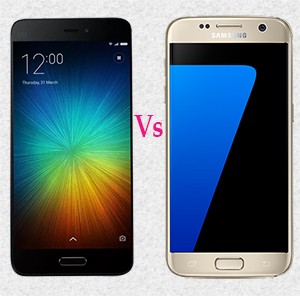
Xiaomi is big in China: the company started by making Apple clones and selling them for super affordable prices, but it has now largely moved past that stage. For quite some time, it's been hard at work to bring a new flagship and recently, it's finally released it: the Xiaomi Mi 5.
While the Mi 5 is not officially available in the United States or Europe, it could be tempting to get a Mi 5 on eBay shipped from China. But let's get this straight right here: unlike other major phone brands like Apple or Samsung, you have no service for the Xiaomi Mi 5 in the US or Europe. If you shatter your screen or some other problems occur, you'd need to rely on third-party repair shops, pay for those repairs from your pocket and wait longer for repairs.
This is probably the biggest downside to owning a Xiaomi phone and it's an important consideration. Now that you've been warned about all this, let's keep it out of the way and focus on the performance of the Xiaomi Mi 5 as we pit it against one of the best Android phones available at the moment: the Samsung Galaxy S7.
Design
both look similar to a very large degree: comparable in size, with a tapered glass back and metal frame. And of course, you can already hear the angry crowds shouting about the Chinese copying again, but don't be so fast in your judgment.
While the Galaxy S7 shares the Galaxy S6 looks, and you might think that Xiaomi copied from Samsung's appearance, the truth is that before that new Samsung Galaxy design language made its debut in spring 2015, Xiaomi had already released its Mi Note (in January 2015), which is in fact the first Android phone to have that tapered glass back/metal frame accents.
With that settled, let's focus on the specifics of each phone. The Xiaomi Mi 5 is the lighter and thinner of the two. It's remarkable how light this phone is, and despite having only slightly slimmer body, that slimness is noticeable. The Galaxy S7 – in stark contrast – has a very noticeable heft in the hand, with a much more solid feel, it's almost built like a tank (if tanks were made of glass). The tapered back does wonders to make both rest very comfortably in the hand. It is such small details that make a huge difference in daily use, and we're glad that both Samsung and Xiaomi paid attention to those.
Display
We're dealing with two absolutely gorgeous screens here: the Galaxy S7 uses Samsung's latest and best Super AMOLED technology in a 5.1” Quad HD (1440 x 2560 pixel) display, while Xiaomi Mi 5 has a very beautiful and vivid 5.15” Full HD (1080 x 1920 pixel) LCD display. While the Galaxy S7 is sharper on paper, it's hard to notice much of a difference in detail or sharpness in real-life usage. To the regular viewer looking at his phone from a hand's distance, both will likely appear equally sharp.
Internet and Connectivity
This could be a dealbreaker: the Mi 5 has very limited 4G LTE support. Chances are it won't work in many European countries, while in the States it will fall back to 3G speeds.
The annoying tradition of bundling duplicate apps on even the best Android phones out there continues with the Galaxy S7 and Mi 5. The S7 features a custom Samsung browser as the first option, and Chrome as the second, while the Mi 5 sports its own browser and then again, Chrome. All of these browsers do a good job accessing the web. We find Chrome to be the fastest and we like the convenience of having synced bookmarks across phone and desktop.
Both the Samsung Galaxy S7 and Xiaomi Mi 5 rock the latest and Qualcomm's most powerful Snapdragon 820 system chip. But that's not telling it all: the Mi 5 actually comes in three different versions with slight differences in the spec sheet as follows:
Base Mi 5 (official MSRP ~$305) has Snapdragon 820 @ 1.8GHz, 3GB of RAM, 32GB of storage
Mid-tier Mi 5 (official MSRP ~$335) has Snapdragon 820 @ 2.15GHz, 3GB of RAM, 64GB of storage
Upper-tier Mi 5 (official MSRP ~$400) has Snapdragon 820 @ 2.15GHz, 4GB of RAM, 128GB of storage
Camera
The Galaxy S7 has one of the best cameras on a phone, so the Mi 5 faces an uphill battle.
But first, let's see what we're dealing with in terms of cameras. The Galaxy S7 has a 12-megapixel camera with a 4:3 aspect ratio, a super wide f/1.7 lens, while the Mi 5 sports a 16-megapixel sensor with an f/2.0 lens. Both shooters have optical image stabilization (OIS), neat for sharper images in low light and steadier videos.
The Mi 5 has a much less intuitive camera app. At first sight, it has virtually no options, but you have to swipe from the left or right to bring some invisible menus with additional options. Getting into the settings to change basic things is also an exercise in frustration: you need to swipe from left to right to see a menu and tap on a little gear icon to get into settings. Then, you need to actually switch to the video mode to be able to tweak video settings. Confusing? Definitely.
What about the image quality and camera experience? Put simply, it's good on the Xiaomi Mi 5, but it's so much better on the Galaxy S7. The fast Quick Launch shortcut is a wonderful thing to have, the camera focuses impressively fast and tracks that focus, and captures sharp images in various conditions. The Mi 5 is much slower to focus and we had some images turn out blurry, especially when we were trying to capture a moving object. Plus, the S7 is great for macros, while the Mi 5 simply cannot focus as close.
|
|


Comments: